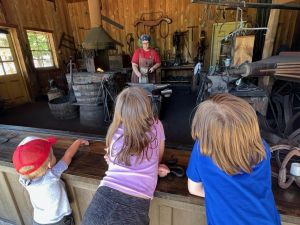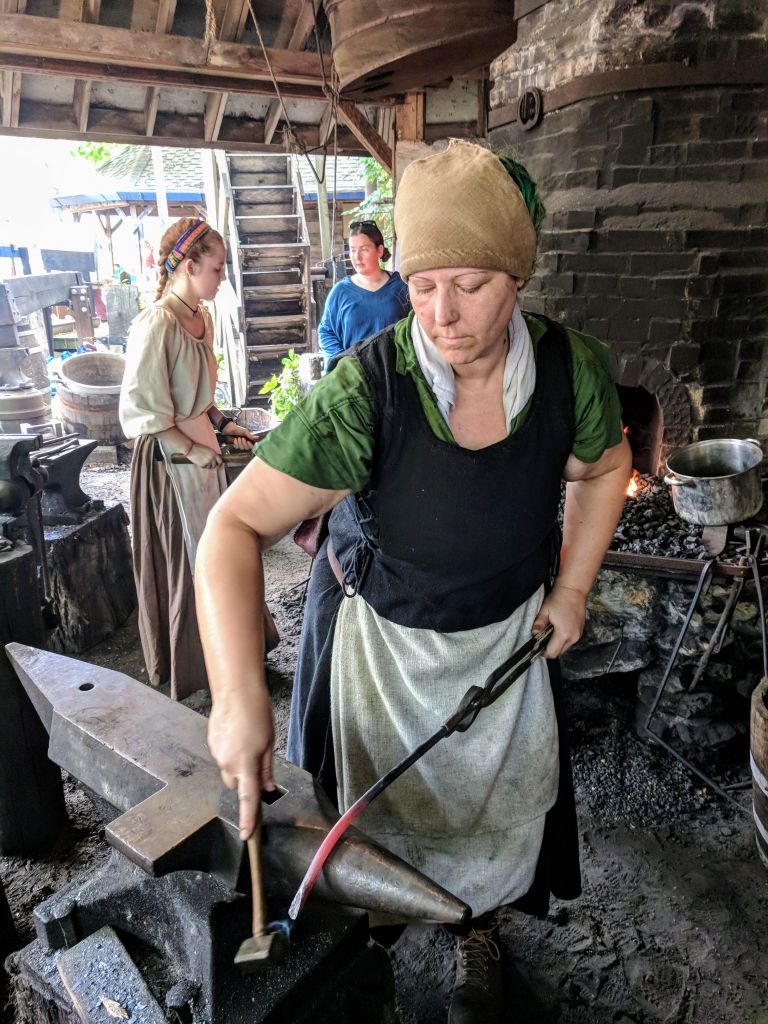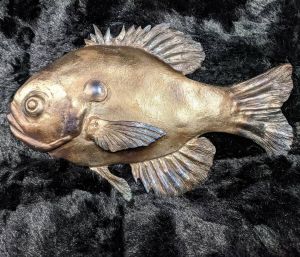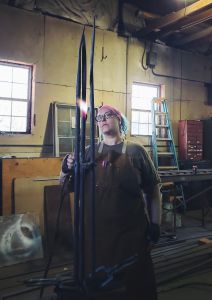ABANA Members in Action
Making Magic in the Forge with Chelsea Brimer
 How did you get started in blacksmithing? You have an extensive history in literature and publishing, so how did blacksmithing enter your life?
How did you get started in blacksmithing? You have an extensive history in literature and publishing, so how did blacksmithing enter your life?

My path to the forge was a winding one. I wanted to be a clay sculptor in high school until my art teacher got tired of me making the same things in his class all the time. My senior year, he introduced me to the small metal shop in the back corner of his classroom and told me not to catch myself on fire. From then on, I was hooked. Unfortunately, I wasn’t an art major in college, but I used my spare electives to take various sculpture classes for fun. I’d planned on returning to metal sculpture as a hobby after gaining solid ground in a career, but life had other plans. After being laid off several years ago, my husband encouraged me to return to art, and a family friend suggested I take a blacksmithing class. He introduced me to a local nonprofit that taught basic blacksmithing techniques, and halfway through the first class I was hooked. I’d finally found what I wanted to be when I grew up!
I think the reason blacksmithing speaks to me so strongly is because steel moves like clay when it’s yellow-hot, so forging steel (as opposed to welding/metal fabrication) feels more like clay sculpting… but with fire and hammers. It’s like high-stakes Play-Doh.

Let’s talk about your work at the Deanna Rose Children’s Farmstead. How often are you there and what are you typically doing?
 The farmstead is open April 1 through October 31, and during that time I am there 4-5 days a week, 5-7 hours a day. It’s a turn-of-the-century, 1901 era farmstead, so my shop uses a coal forge, no electricity, and I work in period-appropriate clothing. I’m on display from the moment my shift begins until I close up at the end of the day, which means I’m just as likely to have crowds watching me perform morning chores as forge steel. So, I spend all day greeting folks, narrating my day, and answering questions as I work. Because my attention is split between crowd and craft, I usually stick to making a handful of easy-to-forge items at the farm like bottle openers, horseshoe hearts, and garter snakes. Easier projects and good muscle memory keep me from being burned or hitting myself with a hammer in front of people as I’m explaining what I’m doing.
The farmstead is open April 1 through October 31, and during that time I am there 4-5 days a week, 5-7 hours a day. It’s a turn-of-the-century, 1901 era farmstead, so my shop uses a coal forge, no electricity, and I work in period-appropriate clothing. I’m on display from the moment my shift begins until I close up at the end of the day, which means I’m just as likely to have crowds watching me perform morning chores as forge steel. So, I spend all day greeting folks, narrating my day, and answering questions as I work. Because my attention is split between crowd and craft, I usually stick to making a handful of easy-to-forge items at the farm like bottle openers, horseshoe hearts, and garter snakes. Easier projects and good muscle memory keep me from being burned or hitting myself with a hammer in front of people as I’m explaining what I’m doing.

What value do you see in demonstrations for kids and families?
 One of the things I love most about demonstrating blacksmithing for kids is getting to show them that this process is still alive — not only as a trade but also as an artform — and you don’t have to be a super-strong dude to do it. Most kids expect to see an old man or a huge, Thor-like dude behind the anvil, forging horseshoes or swords and knives. I love watching children’s eyes light up when they see a young(ish), green-haired, lady smith at the forge making hearts, snakes, feathers, and pumpkins out of steel instead. It’s like adding a bit of magic to their lives; suddenly, possibilities abound in the world around them. And the excited gasps and shouts I hear when I pull hot steel from the forge add a bit of magic to my life, too.
One of the things I love most about demonstrating blacksmithing for kids is getting to show them that this process is still alive — not only as a trade but also as an artform — and you don’t have to be a super-strong dude to do it. Most kids expect to see an old man or a huge, Thor-like dude behind the anvil, forging horseshoes or swords and knives. I love watching children’s eyes light up when they see a young(ish), green-haired, lady smith at the forge making hearts, snakes, feathers, and pumpkins out of steel instead. It’s like adding a bit of magic to their lives; suddenly, possibilities abound in the world around them. And the excited gasps and shouts I hear when I pull hot steel from the forge add a bit of magic to my life, too.
Another valuable aspect of demonstrations is that I get to show kids that physical labor isn’t always something to be avoided or thought of as bad. I started out my adult life with a cushy office job and absolutely hated it, and a lot of kids find that surprising. They assume I do hard work because I didn’t go to school or couldn’t get a better job, and they’re floored when I tell them that this — swinging a hammer all day next to a hot fire — is my absolute dream job.

Any specific experiences working at the Farmstead that you’d like to call out?
 One of the coolest things to happen so far is that I recently got my television debut while forging at the farm. Last summer, the farm was approached by “Bargain Mansions,” a home-renovation show on the Magnolia Network, who wanted a Kansas City area blacksmith to make a fireplace poker set for the house they were renovating. They’d heard there was “a cool, green-haired, lady blacksmith” at Deanna Rose Farmstead and wondered if we were interested in working with them for an episode. Long story short, the host of the show came to Deanna Rose one day with a big television crew, they filmed me teaching the host how to forge a fireplace poker, and about 3 months later I had the privilege of watching myself forging steel on cable TV! Best of all, it went so well they came back and filmed a second episode at the farmstead in October. (I’m told that episode will air sometime in March or April of this year.)
One of the coolest things to happen so far is that I recently got my television debut while forging at the farm. Last summer, the farm was approached by “Bargain Mansions,” a home-renovation show on the Magnolia Network, who wanted a Kansas City area blacksmith to make a fireplace poker set for the house they were renovating. They’d heard there was “a cool, green-haired, lady blacksmith” at Deanna Rose Farmstead and wondered if we were interested in working with them for an episode. Long story short, the host of the show came to Deanna Rose one day with a big television crew, they filmed me teaching the host how to forge a fireplace poker, and about 3 months later I had the privilege of watching myself forging steel on cable TV! Best of all, it went so well they came back and filmed a second episode at the farmstead in October. (I’m told that episode will air sometime in March or April of this year.)

With regards to Medusa Metalwork, what kinds of work do you take on through your business?
 Medusa Metalwork is where I get to showcase larger, more elaborate, and more artistic pieces commissioned by clients. I’ve made wall art (multiple beta and bluegill fish), a garden gate with a stained-glass inlay, custom stands for geode and fossil collections, and dozens of small gift items like grilling forks, bottle openers, necklace pendants, etc. However, my home shop is still in its infancy, so it’s difficult to make what I want to make with the space and tools I currently have. And working on the shop as well as working on pieces in the shop only happen in spare moments between work at the farmstead, house/life chores, home projects, and family time, so I don’t take on many projects. But! I’m currently sketching out a sculpture of a client’s dog (a life-size mastiff!) that she wants me to make for her garden, and I have a few other projects on the back burner that I’m looking forward to starting soon.
Medusa Metalwork is where I get to showcase larger, more elaborate, and more artistic pieces commissioned by clients. I’ve made wall art (multiple beta and bluegill fish), a garden gate with a stained-glass inlay, custom stands for geode and fossil collections, and dozens of small gift items like grilling forks, bottle openers, necklace pendants, etc. However, my home shop is still in its infancy, so it’s difficult to make what I want to make with the space and tools I currently have. And working on the shop as well as working on pieces in the shop only happen in spare moments between work at the farmstead, house/life chores, home projects, and family time, so I don’t take on many projects. But! I’m currently sketching out a sculpture of a client’s dog (a life-size mastiff!) that she wants me to make for her garden, and I have a few other projects on the back burner that I’m looking forward to starting soon.

Any favorite projects you’d like to focus on/mention?
 So far, my favorite projects have been ones that taught me the most and utilized more than just my forging skills. Probably my absolute favorite is the garden gate I made for a friend. It was the first commissioned piece I’d ever made, and I had NO IDEA what I was getting myself into. Making that piece was an entire four-year college degree’s worth of education, all wrapped up in a few simple lines and curves (…plus a stained-glass inlay and a spring-loaded finger pull). But when it was finished — with extensive help from my mentor at the time, Mike Nave — it was a genuine work of art. It’s one of the few pieces I’ve made that looks exactly like the original concept in my head, and it’s functional to boot.
So far, my favorite projects have been ones that taught me the most and utilized more than just my forging skills. Probably my absolute favorite is the garden gate I made for a friend. It was the first commissioned piece I’d ever made, and I had NO IDEA what I was getting myself into. Making that piece was an entire four-year college degree’s worth of education, all wrapped up in a few simple lines and curves (…plus a stained-glass inlay and a spring-loaded finger pull). But when it was finished — with extensive help from my mentor at the time, Mike Nave — it was a genuine work of art. It’s one of the few pieces I’ve made that looks exactly like the original concept in my head, and it’s functional to boot.

Do you have any “bucket list” projects you’d like to eventually tackle?
 Oh my gosh. I have so many. For starters, I have grand visions of replacing my son’s tree house ladder with the reclaimed spiral staircase that’s currently decaying on the ground in our backyard. But probably my biggest bucket list project is, weirdly, a giant chicken. I have an uncle who’s been badgering me for years to make him a 6-foot tall metal chicken… and an aunt who’s been begging me for years not to. I’d LOVE to forge a giant metal chicken that both makes my uncle laugh (the whole reason he asked for it) and is so beautiful and/or interesting that my aunt loves it, too. I think, if I could turn that joke request into a permanent installation piece they loved, I could probably die happy after that.
Oh my gosh. I have so many. For starters, I have grand visions of replacing my son’s tree house ladder with the reclaimed spiral staircase that’s currently decaying on the ground in our backyard. But probably my biggest bucket list project is, weirdly, a giant chicken. I have an uncle who’s been badgering me for years to make him a 6-foot tall metal chicken… and an aunt who’s been begging me for years not to. I’d LOVE to forge a giant metal chicken that both makes my uncle laugh (the whole reason he asked for it) and is so beautiful and/or interesting that my aunt loves it, too. I think, if I could turn that joke request into a permanent installation piece they loved, I could probably die happy after that.

What advice would you give to someone wanting to strike out as an independent blacksmith?
 Don’t do it unless you love the process even more than the product. And if you want to make a living, mechanize and electrify as much as possible. Electricity and power hammers are your friends!
Don’t do it unless you love the process even more than the product. And if you want to make a living, mechanize and electrify as much as possible. Electricity and power hammers are your friends!

What did you think of the Bear’s Head Class? Do you foresee the material helping you in the future?
 The Bear’s Head Demo was great, and I will 100% be utilizing those techniques ASAP — the shaping techniques for the faces, obviously, but more importantly the tooling information. Coming to smithing from an art background means toolmaking and heat treating are my weak spots. I have a bad habit of making single-use tools. Hehe.
The Bear’s Head Demo was great, and I will 100% be utilizing those techniques ASAP — the shaping techniques for the faces, obviously, but more importantly the tooling information. Coming to smithing from an art background means toolmaking and heat treating are my weak spots. I have a bad habit of making single-use tools. Hehe.

Anything else you’d like to mention, plug, discuss, etc.?

I’m hoping to attend more ABANA classes in the future and eventually become certified at various levels.
Note: You can check out the videos for the Bear’s Head Class mentioned above (which included toolmaking and 5 different animal heads) on our YouTube channel.
Do you know an ABANA member with an interesting story to tell or project to discuss? Drop us a line at socialmedia@abana.org and we’ll take it from there!







